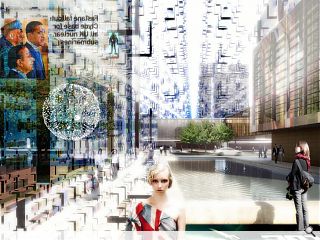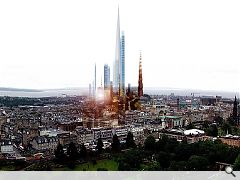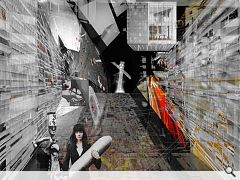Future urban environments
28 Apr 2011
The 21st century will see a revolution in building technology and urban environments. In the medium term, the most important change will be the availability and production of energy. For the last 150 years, our civilisation has relied on a cheap and abundant supply of oil – something we’ve tended to take for granted. We’re now approaching what’s known as “Peak Oil”, the point at which the amount of recoverable oil is exactly 50% depleted, after which it goes into terminal decline. This will have enormous implications for society and the economy. According to some sources we have already passed this point and are now seeing its early effects.
Transport will be the sector most directly affected, with the cost of travel likely to become much higher by the end of this decade. In a worst-case scenario, the economy may well collapse, as oil becomes simply unaffordable. A sudden spike in fuel costs could trigger a series of chain reactions, potentially spelling the end of industrial civilisation itself.
Food is another sector likely to be hit hard by rising oil prices. It will no longer be energy-efficient and cost-effective to ship fruit, vegetables, meat, fish and other items halfway around the planet. Likewise, modern farming techniques use oil-based machinery, fertilizers and pesticides in huge amounts. What may start to happen is an increasing localisation of agricultural production, with much more food being grown in residents’ own gardens and community allotments – similar to what happened in Cuba following the collapse of the Soviet Union. In high-density urban areas, where green land is scarcer, this could take the form of vertical farming. By 2025, experimental “farm skyscrapers” could start to appear in UK cities. An urban site of just 1.3 hectares (3.2 acres) could provide the same amount of food as 420 hectares (1052 acres) of traditional farmland, and would feed tens of thousands of citizens. This vast increase in efficiency would be achieved using tightly controlled growing environments, with hydroponics and other technologies stacked on multiple levels. The towers could also incorporate their own power generation in the form of photovoltaics or rooftop turbines.
In the longer term, energy will become less of an issue, as algae biofuel and synthetic fuels replace traditional petrol completely, solar and wind see exponential growth, and fuel cells/energy storage systems are perfected. Energy will become more and more decentralised, with substantial numbers of homes and offices using their own rooftop solar generation.
Eventually, “solar roadways” may start to appear, providing yet another energy source. These would allow motorways, roads, parking lots, driveways and even pavements to create electricity, using photovoltaics. Traditional asphalt and concrete surfaces could instead be replaced by super-strong, self-healing glass and solar panels capable of being driven and walked upon.
Besides the production of clean, abundant and decentralised energy, these hi-tech surfaces would have other advantages. In winter, for example, they could heat themselves with embedded heating elements (similar to the rear window of a car), eliminating ice and snow build-up. Cities would no longer have the expense of snow removal and the problems caused by the chemicals (salt, magnesium chloride, etc.) used to maintain clear roads. Businesses would no longer have to worry about keeping their parking lots cleared, while homeowners would no longer have to suffer through winters of shovelling or ploughing snow off their driveways and sidewalks. A huge number of deaths and injuries would be prevented just by keeping the roads safe and dry.
In addition, LED signage could be built in, creating "smart" roads that dynamically responded to traffic, weather and emergencies. Nanotechnology would greatly reduce the cost of these roadways, and they would pay for themselves by selling power back to the grid.
Realistically, solar roadways are probably several decades away from being widespread. However, there are many other changes in urban environments that will happen much sooner.
By 2020, there will be smart meters in every UK home. These will have an electronic display showing customers precisely how much electricity and gas they are using and their costs in real time. Data will be relayed back to energy firms automatically, so that estimated bills and visits from meter readers will be a thing of the past. Average bills will be reduced as a result, since the meters will encourage changes in behaviour. The meters will also "talk" to domestic appliances such as refrigerators. If necessary, these could be made to switch on and off depending on the level of demand on the grid.
The Internet will undoubtedly continue its exponential growth, not just in homes but in outdoor areas too. Wi-Fi will become ubiquitous in cafes, shops, airport terminals and on public transport. Another new technology, known as Wi-Tricity, will also emerge. Laptop users will be able to utilise a power connection, as well as an Internet connection. Power lines will begin to disappear from streets, with electricity passed wirelessly from building to building. This could be common in towns and cities by the mid-late 2020s.
Interactive surfaces and web technology will be increasingly used in architecture, interior and exterior designs. Multi-touch sensitive displays with live video streaming and other features will be embedded in shops, cafes, restaurant tables, street furniture, outdoor signage and information boards – as well as surfaces in the home such as walls, doors, mirrors and worktops. These ultra-thin, printed electronics will have super-fast net connections and seamless integration with mobile devices, to fully personalise the user experience.
Similarly, a new form of “intelligent advertising” will emerge. Personalised adverts - similar in style to those seen in the film Minority Report – are already being trialled in Japan, and could be widespread in UK cities by 2030. Microsensors embedded in posters and other outdoor media will identify people by the chips in their mobile phone, credit card and other personal effects. The adverts will then be customised, depending on the interests and lifestyle of the person in question. Pairs of ultrasonic beams, targeted to intersect at specific points, will deliver a localised sound message that only a single person can hear. This means that even in crowded situations, the adverts will be made personal and unique.
Augmented Reality, having already entered the mainstream in 2010, will see explosive growth in the 2020s. In combination with on-person devices (such as glasses, or web-enabled contact lenses), this could play a major role in the attraction and appeal of urban environments.
By the early 2030s, holographic technology will be sufficiently advanced that large-format, outdoor displays will be possible. These will be found in sports stadiums and Olympic venues, outside major cinemas, in public squares and other prominent areas, with graphics appearing to literally “jump out” of screens, a la Back to the Future II.
From the mid-2030s onwards, self-driving vehicles will start to become widespread. These will use a combination of GPS, AI and lane-changing technology, to automatically carry passengers to their destination. By the 2050s they will be ubiquitous. Advanced and highly intelligent road networks will be in place throughout the country. Practically all vehicles will be computer-controlled, with traffic jams and crashes becoming a thing of the past. Cars will be lighter, safer, smarter and more efficient.
By the 2040s, claytronics will be a common feature of new buildings and vehicles. This technology will involve microscopic devices known as catoms – joined electrostatically in vast numbers – and working in concert to produce changes at the macroscale. This form of “programmable matter” will enable surfaces, colours and textures to be altered at the touch of a button. Windows could be instantly blacked-out for privacy, or to shield occupants from the Sun. Walls, floors and doorways could morph into completely new styles. Vehicle and building surfaces could also self-heal: fixing cracks, dents and other damage.
Further into the future, nanotechnology will revolutionise architecture and urban environments, offering protection from the worst that global warming can throw at us. It will ultimately become possible to design entire buildings with atomic precision, creating endless applications.
A new generation of super-strong materials will emerge. Skyscrapers could reach miles into the sky, or feature insanely complex designs. Buildings could be made completely resistant to dirt, bacteria, weather, graffiti and vandalism. These same coatings would be applied to public transport, cars and other vehicles which would appear brand new, shiny and in perfect condition at all times. Special absorbent materials, embedded in roofs and guttering, could soak up the rain, filtering and converting it to drinkable water. A similar class of nano-materials could “breathe” CO2 and convert it back into oxygen, helping to reverse the effects of climate change.
Buildings could be 100% clad in solar photovoltaics – even historic old landmarks – without an observer even noticing. The use of metamaterials in combination with nanotechnology could enable the use of partially or wholly invisible components, creating a number of striking visual effects.
Lamp posts, telegraph poles, signs, bollards and other visual "clutter" that festoons our streets will eventually disappear. Electricity will be passed wirelessly from building to building. Lighting will be achieved more discretely, using self-illuminating surfaces and objects designed to hide these eyesores, thus maximising pedestrian space and aesthetics. Even trees and plants could be made to self-illuminate, using nanotechnology. Sign posts could be made obsolete through the use of Augmented Reality.
Room temperature superconductors - implanted in the ground – will allow the rapid movement of vehicles without any need for tracks, wheels, overhead cables or other bulky components. Cars and trains will simply drift along silently, riding on electromagnetic currents.
3D printing, if scaled up, would enable the automated construction of buildings with little or no human involvement. Atom-by-atom, intelligent machines would lay the foundations, core, framework, flooring, electrics and other components – with robots inspecting the interior, performing safety checks and making adjustments where necessary. The process would be so rapid that new homes could be “printed” within a few days, entire skyscrapers in weeks.
By 2100, technology could be so exponentially advanced, and progressing at such a rapid pace, that even 3D printing may seem primitive by comparison. Who knows what the 22nd century will have in store? Perhaps by then, humans will have merged their minds with the Internet, and most “architecture” will be experienced in virtual environments.
Will Fox
www.FutureTimeline.net
|
|





